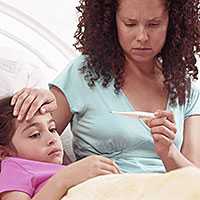Symptoms and Illnesses
 Human parainfluenza viruses (HPIVs) commonly cause upper and lower respiratory illnesses in infants and young children, but anyone can get infected. After you get infected, it takes about 2 to 7 days before you develop symptoms.
Human parainfluenza viruses (HPIVs) commonly cause upper and lower respiratory illnesses in infants and young children, but anyone can get infected. After you get infected, it takes about 2 to 7 days before you develop symptoms.
Symptoms of upper respiratory illness may include—
- fever,
- runny nose, and
- cough.
Symptoms of severe lower respiratory illness may include—
- croup [an infection of the vocal cords (larynx), windpipe (trachea) and bronchial tubes (bronchi)],
- bronchitis (swelling of the main air passages that connect the windpipe to the lungs),
- bronchiolitis (swelling in the smallest air passages in the lungs), or
- pneumonia (an infection of the lungs).
Young children are more likely to have severe illness, but older adults and people with weakened immune systems are also at risk.
Other symptoms of HPIV illness may include—
- sore throat,
- sneezing,
- wheezing,
- ear pain,
- irritability, and
- decreased appetite.
You can have multiple HPIV illnesses in your lifetime.
Different Types of HPIVs
- HPIV-1 and HPIV-2 both cause croup, with HPIV-1 most often identified as the cause in children. Both can also cause upper and lower respiratory illness, and cold-like symptoms.
- HPIV-3 is more often associated with bronchiolitis, bronchitis, and pneumonia.
- HPIV-4 is recognized less often but may cause mild to severe respiratory illnesses.
- Page last reviewed: August 18, 2015
- Page last updated: August 18, 2015
- Content source:


 ShareCompartir
ShareCompartir